Bachmann are one of a number of major producers of model railways that include some figures in their range. These figures claim the railway scale of 'OO', which is 1/76th scale, so a bit small compared to 1/72nd scale figures, but in fact all seem about right for 1/72 scale. They come in small sets of 6 to 12 figures and are assembled and painted at the factory, presented in appealing blister packs that make it easy to see the figures before you buy. The quality of the sculpting is fairly basic, but the painting is not bad considering they are mass-produced, and of course they are not expected to be closely scrutinised anyway, but rather seen as a minor decoration on some layout where the trains are the stars. None come with bases, which is a bit annoying even if they are to be used on a layout.
Naturally the subject matter is mostly train operators and passengers, and all are for the 20th century or later, but nevertheless they could provide possibilities for the military modeller, and doubtless many visitors will be thinking of converting and/or repainting them to their own needs. A handful of the sets are of particular interest to military modellers, but here we have included all the figures in the range, along with very brief comments on their usefulness.
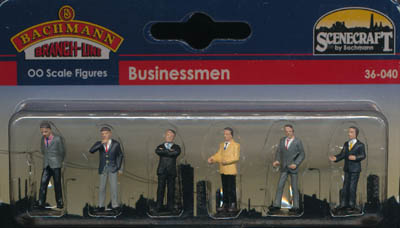
Average Height: 23 mm
In Britain and many other countries, a large percentage of railway travellers are commuting to work, so it must have made sense for Bachmann to start their range of railway figures with a set of people doing just that. Half these men wear a suit and half non-matching jacket and trousers, though the difference is only one of paint. To be honest, the suit was almost universal amongst businessmen, so the others have a rather more casual look, particularly the one who has chosen his yellow jacket for today's outfit.
It is not easy to see what else these figures could be used for apart from what they are, though even as businessmen they all lack a briefcase or similar, which seems an odd omission to us, given that they are supposed to be in the street or waiting for a train. However one subsequent change in society is that, in recent years, many firms no longer require their staff to wear formal attire such as a suit, though there are still enough that do to keep this set relevant. Smart menswear covers a pretty wide time frame as changes in such fashion tend to be small, but of course all these figures are quite modern. Just the fact that none are wearing a hat makes them best suited for the 1960s or later.
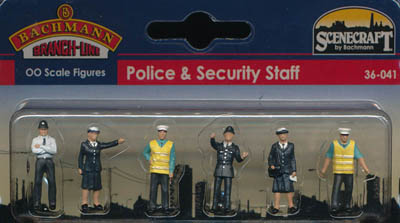
Average Height: 23.5 mm
Like all the Bachmann range, this set depicts British subjects, in this case law enforcement and security personnel. Generally the sets are either described as belonging to a certain time period, or else are assumed to be suitable for today, but this set is different.
The police figures have a fairly old-fashioned look to them, and that is because police uniform has changed a great deal in the past 20 years or so. The first two constables wear the No.1 dress jacket and shirt sleeves, and both have the custodial helmet so recognisable worldwide as British police uniform. In fact today police generally wear high-visibility jackets and/or stab vests, and they also have a duty belt which carries a large number of items (such as would make Batman jealous). These two figures carry nothing, and so have an appearance almost never seen these days except perhaps at certain formal occasions such as passing out parades. The custodian helmet is still worn in the majority of British forces as at the time of writing, although a peaked cap is also common, but the headgear of the two female officers, which is a peaked cap, is no longer in use. This design, similar to a version worn in the Royal Navy, has since been replaced by a bowler style headgear. In addition, most female officers wear trousers rather than a skirt, and the same sort of upper body wear as the men, i.e. jacket, tactical vest, plus of course a duty belt. So again these figures are not relevant to modern Britain but one at least 20 years ago.
Lastly, the final two figures are simply labelled as security staff, and as such they of course do not follow any rigid uniform standards. However both wear peaked caps and high-visibility jackets over a mid-green shirt which would still be reasonable today.
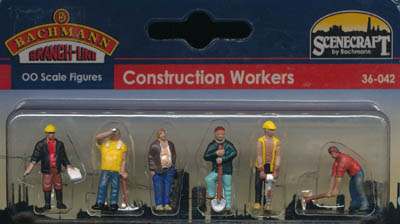
Average Height: 23 mm
Construction workers are common enough in urban areas, but these have a very old-fashioned appearance. That is because only one man is wearing any sort of high-visibility clothing, and most have no form of hard hat, so wouldn't be allowed anywhere near a construction site in recent years. Still useful for people doing small works in private homes, for example, or layouts themed on periods of a few decades ago, but we thought these were some of the weakest examples of sculpting in this range. The general anatomy is not good, and the man with the spade is quite flat. Although we liked both the poses with a pick, overall the figures did little to pique our interest, and not easy to think of military uses either, so not an impressive or particularly worthwhile collection.
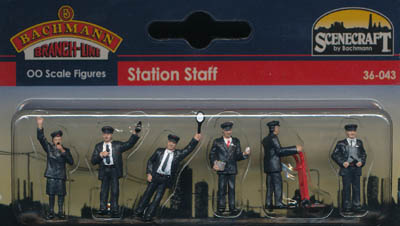
Average Height (men only): 24 mm
These are modern figures, and all the men wear the same basic uniform of smart trousers and jacket over a white shirt and tie, with a peaked cap on top. The woman blowing the whistle has a similar outfit to the men but with a skirt and some sort of peak-less cap. The first figure has a ticket machine, and figures three, four and five all seem to be waving off the train, while the last holds a radio and looks to be in charge. Different companies within the British transport system have different uniform regulations, but everything here looks fine, though the luggage trolley, called a sack truck, looks old-fashioned to us and to be honest we have not seen such an item at any railway station for many years, though perhaps they still exist in goods yards. Today stations tend to have the four-wheeled case trolleys also seen at airports, and those are of course self service.
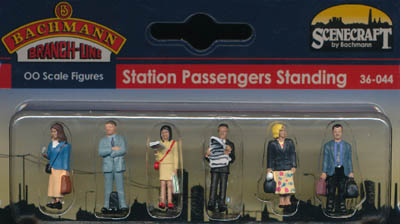
Average Height (men only): 24 mm
Anyone that has travelled on a train has seen these people on the platform. The man carrying two bags looks ready to board, but the rest are reading a newspaper, a book (more likely a kindle these days), looking at their phone or simply staring into space lost in their own thoughts. All perfectly natural, but to be honest none look like they are in a war zone, so perhaps not much utility in these figures for those of us with something more dramatic in mind.

A pretty simple set this; half a dozen people sitting reading a newspaper, looking at their phone or just patiently waiting for a train that will probably pass through the station several times a minute but rarely stop and never let them on! Although the title refers to a station, the figures could just as easily be sitting on a public bench or elsewhere, so a very necessary part of any layout. The last figure is a good, natural pose, but for us the rather crude attempt to make him wear sunglasses using paint just looks ridiculous - it looks more like he wears the sort of domino mask that comic-book heroes of the 60s used to wear as an alleged form of disguise!
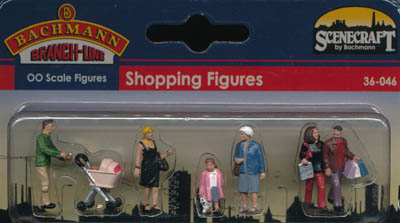
Average Height (men only): 24 mm
We would have to admit that it is hard to see any of these figures in a military context. We really liked the couple holding hands (achieved using two separate pieces), but thought the choice of pure white for painting the old lady's hair was a bit extreme. We earnestly hope that the child is holding a soft toy by the ears and not a real animal, but while she could pass as a refugee for World War II, for example, the rest of the figures probably only really work in their intended role, of decorating a model railway high street. As such they are fine, although perhaps the pram is rather old-fashioned these days.
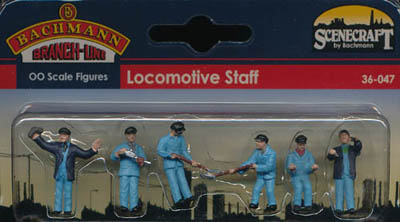
Average Height: 23.5 mm
All these figures are dressed in coats and peaked caps, and the two with the coat open reveal a waistcoat underneath. This is fairly typical working man's attire for the middle of the 20th century, so suitably repainted these could be a variety of workmen. To our eye we think the poses begin with two locomotive drivers (the second is sitting, though it is hard to tell in our photo), then two firemen, then someone with an oil can and finally someone that is perhaps cleaning or polishing their engine. Some scope there for workmen on all sorts of construction sites, such as digging defences around Britain in 1940 or Moscow in 1941, Also the last figure could work well as a civilian surrendering.
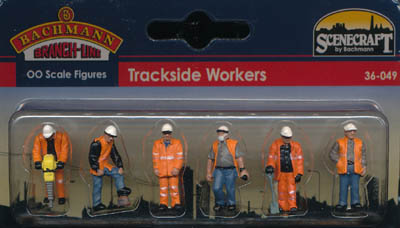
Average Height: 23 mm
This is an obvious inclusion for a range dedicated to model railways. High-visibility clothing was first introduced on Britain's railways in the mid 1960s, so that and the hard hats help to date these figures to relatively modern times (though the style is very much of the present era). Like many in the series, one of the figures here is made up of more than one piece, so naturally is assembled and glued before being painted in the factory, but the resulting pose is more natural, even if the join, while good in this set, is not always so seamless. No particular military applications spring to mind with this set, though of course modern military engaged in engineering or construction projects will often also wear high-visibility clothing - something of a contrast to their normal camouflage clothing worn underneath!
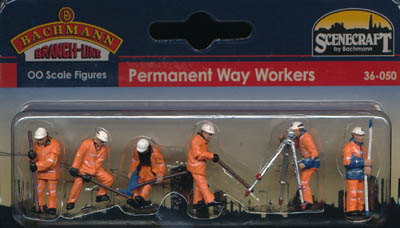
Average Height: 24 mm
What we have here is two men using a theodolite to survey some piece of land, and four others using levers (we won't pretend to understand track-laying tools) to lay track. All wear jackets and trousers painted as high-visibility, and hard hats on their heads, making them fairly typical of many kinds of construction workers. The survey team might be hard to find an obvious use for outside the civilian arena, but the rest could be adapted to various pioneer or artillery roles potentially. Most of these poses benefit from multiple parts which make them very realistic and anything but flat, with quite nice detail on the equipment.
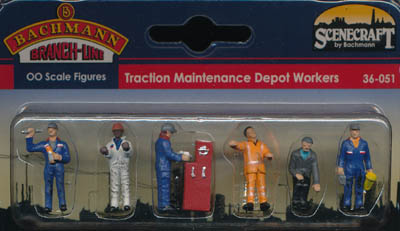
Average Height: 23.5 mm
Never having seen inside a 'Traction Maintenance Depot', we can offer no meaningful observations on the quality of these figures. Most of them look like they are operating heavy machinery, but the man on the far right seems to be linked with the red thing, which may perhaps be some form of storage. Doubtless some train enthusiasts will know what they are doing, but for our purposes we saw overalls and caps and thought of tank crew or men maintaining any sort of vehicle or modern weapons system. Simple overalls like these perhaps date back to the early days of motor vehicles, the last years of the 19th century, so there is a fair amount of scope for use in any conflict of the last century and more.
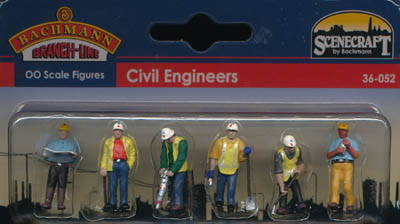
Average Height: 23.5 mm
Civil engineers, construction workers, builders or just plain workmen, call them what you will, these guys are a common sight in all our towns and cities. All wear hard hats, which are in the European style except for the man using the drill, who seems to have one in the American style. Like the rest of this range, these unbased figures mostly fail to stand on their own, though the fourth man along in the red shirt, who is leaning on his pick, has the head of this below the level of his feet, so will be a challenge to have a base added. These are more modern figures than some earlier ones from Bachmann as they all wear at least a hard hat, and many wear high-vis clothing too, so are appropriate for a layout or diorama set in the present day.
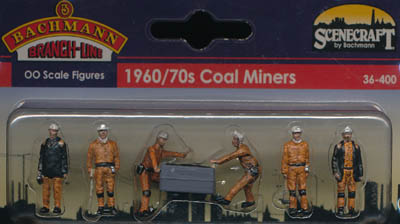
Average Height: 23.5 mm
This must be one of the most surprising choices for a set of figures. Many a railway layout will have goods trains with coal trucks, and during the 1960s and 70s the railways were a major transporter of coal in the UK, but unless you are going to put a coal mine on your layout it is hard to see why you would need some miners. In fact four of the poses are very sedentary and frankly quite dull, merely standing there, but the two men moving the mine cart are quite realistic and work well. However again it is hard to imagine how you would incorporate this in a layout. The painting is actually quite good on these figures, and in particular the grime is nicely done. Very much a special interest set however.
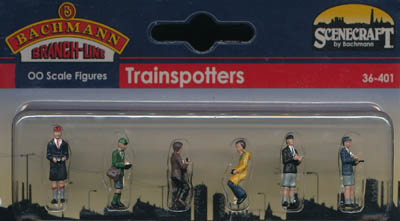
These are all adolescents, almost certainly boys, and they have a very old-fashioned look to them. The first four all wear what used to pass for school uniform back in the 1950s and 1960s, for example, including short trousers, blazers and school caps. The first holds a camera which clearly pre-dates the invention of the smart phone, and the others have notebooks (the paper kind undoubtedly), while the boy in green also has a satchel on his shoulder. Figures five and six are more casually dressed, but still have the feel of at least a generation ago, which is quite understandable. These last two are half sitting - presumably perched on a fence or railing somewhere, and again one has a large (by modern standards) camera. We do not know if many children still indulge in trainspotting, but they certainly do not look like this any more. Another fascination small boys often have is with military hardware, so perhaps these youngsters could be watching some tank, but essentially there is little obvious military use for these pacific figures.
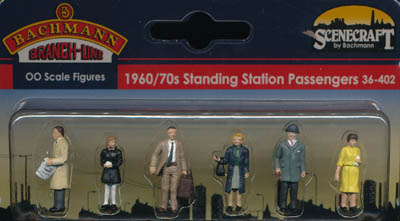
Average Height (men only): 23.5 mm
More railway passengers, this time from the 1960s and 1970s. The man in the suit and carrying a case is pretty timeless, but the rest do have a feel of those decades.
Average Height: 23 mm
This collection of men in overalls is a nice mix of figures doing various non-specific tasks that would work well in all sorts of light or heavy industrial scenes, and would be appropriate for quite a long period of time. For the military modeller there would be many uses, such as in tank parks and motor pools all over the world, not to mention other areas such as naval and aviation scenes. The short man at the end with thinning, grey hair is clearly meant to be the foreman, so is not quite so useful, but most of these figures could be very useful indeed for all sorts of modellers.
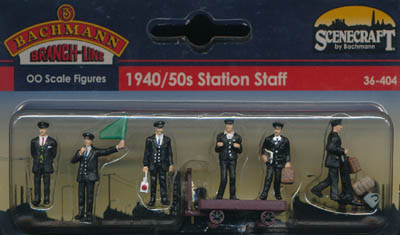
Average Height: 22.5 mm
Britain’s railways suffered during the War due to an understandable lack of investment, followed by nationalisation in the late 1940s and modernisation (including replacement of steam) in the 1950s. Such a major period of change is also a popular one for model railways, particularly as it is the last hurrah for steam, so such a set of railway staff to match makes good sense. Our top row shows various platform staff, starting with what might be a station master with his pocket watch chain visible. Like the rest he wears a smart jacket and trousers with a waistcoat and a peaked cap, and is typical of the period. The guard with the flag and whistle is similar, as are the other two. We particularly liked the man carrying the lamp, but all are quite nice. The bottom row contains the two porters, one with a sack truck, plus a trolley (held by the second man) and several pieces of luggage - small but nicely done. The sculpting is reasonable but the factory painting quite basic, and apart from the obvious use in some World War II railway diorama there is little else that can be done with these figures. Still worth knowing about if some domestic scene is contemplated from the War or soon thereafter.
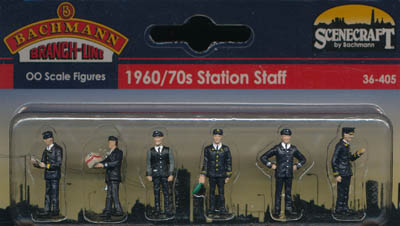
Average Height: 23.5 mm
Labelled as for the 1960/70s, these figures wear the jacket and peaked cap that was introduced by British Rail during the mid 1960s, though it must be said the sculpting is not very sharp, and the cap in particular is rather a mess here. We wonder if the man with the grey sleeves is a porter, but the rest are in a smarter uniform. The first man carries a parcel and the second holds a flag for waving away the train (though again poorly sculpted), while the third holds some long narrow item we could not recognise. Given the particular cut of these uniforms, there is little scope for using these figures anywhere else, unfortunately, but as BR staff they are fine.
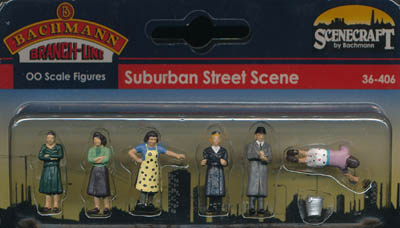
Average Height (of man): 23 mm
This is another set with very little potential for military uses. What we have here is several standing women, perhaps talking to each other, and another on all fours scrubbing with a bucket close at hand. This all paints a picture of low-quality terraced housing dating back to the Victorian era in Britain, where houses are narrow and open directly onto the street pavement, and so front doors are close together. This very proximity encouraged a strong social attitude amongst the women who stayed at home while the husband went to work, so it would be very normal to see pairs or small groups of women clustered around one door conversing in this way. Despite the fairly poor housing, many took great pride in the outward appearance of their homes, and spent much time in cleaning windows and, especially, the doorstep to the front door. This would explain the woman on her knees scrubbing.
The last two characters are rather different. As far as we can tell, the woman in uniform is some sort of district nurse, providing primary healthcare to households such as we have described. She would be known to most such households, and was a key element of the local community. Here she holds both hands out, but for what purpose we cannot tell. The last figure is the only man in the set, and he wears a shirt and tie, brimmed hat and long overcoat as would have been common until recent decades in Britain. He holds some sort of file or case under his left arm, and has something like a notebook in his hand, and our first thought was he depicts a rent-collector, or perhaps a door-to-door rep such as might collect insurance premiums on a weekly or monthly basis. Of course he could fulfil several roles, but this is likely to be the intent in our view. This of course is not something that happens much today, so although no date is applied to this collection of figures, we thought the old-fashioned clothing and the implied roles gave this set a very old flavour, perhaps no more recent than the 1970s, at least in Britain. That is not to say it could not be seen even today, but changes in modern society make it much less common than a generation or two ago.
So another set with human interest appeal but not much potential for any military scenario. Still it offers some civilians who would probably work well for World War II or even earlier.
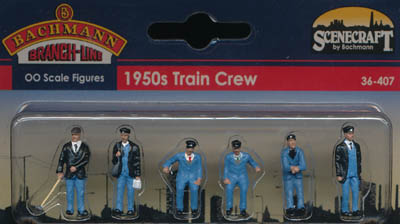
Average Height: 23.5 mm
During the 1950s Britain's railways used steam, diesel and electric locomotives, so these figures could be driving some very diverse engines. The third man is a wheel-tapper, using his hammer to tap wheels to detect faults in them, though this job was phased out at this time due to better maintenance and better quality wheels. He seems rather smartly dressed for such a job. The last three figures are all for the cab itself.
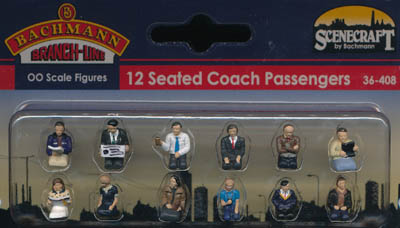
These figures, all seated and chopped off at the knees, are obviously meant to be positioned inside railway carriages. In our humble opinion, such figures are not nearly as well used as they should be, since it is common to see layouts - even quite expert ones - with trains pulling carriages without a single passenger, which reduces the realism and ignores the sole reason that passenger trains exist at all - to move people about. For the military or wider modelling community, these figures could equally well be placed inside a multitude of vehicles of any sort, so perhaps they can be repainted and used to decorate some of the many vehicle kits that are still sold without any occupants.
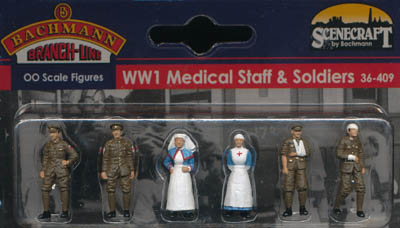
Average Height: 24.5 mm
For fans of military modelling this is more like it. In fact this is a very surprising set for a railway company, and was made to complement their WWI ambulance train set, but for us it provides some really useful British Great War medical figures and some casualties.
The first two are part of the RAMC, and at the front they would be bearers or orderlies, responsible for tending and evacuating the more seriously wounded, though they would normally have worn a red cross armband on the left arm, which neither here do. Since these men are beside an ambulance train they are well back from the front, and so are presumably orderlies. Both have the correct red cross badge on each upper arm, though here they are grossly larger than the very small actual insignia. Like the rest of the Army they wear standard service dress and peaked caps. The second man has what appears to be a stiffened cap, looking like the first type issued, while the other may have removed this stiffening.
For some the highlight is the pair of nurses, as very few such women have yet been modelled in this scale. Both are perfectly accurate in costume, though like the men their lack of action makes them fairly dull poses.
Finally we have a pair of casualties. As usual their apparent injuries are very neat and acceptable to a modern audience - one man as an arm in a sling and the other a bandage round the head and another round a wrist. Both wear the normal service dress and have no belts or webbing. The cap is again unstiffened, and like the orderlies the uniform is reasonably well done.
The basic factory paint job does not flatter these figures, but their sculpting is pretty reasonable. The inactive poses do not help matters, and the lack of any bases is not helpful either, but these are still useful figures for an important but inevitably neglected aspect of the Great War. Only the Airfix WWI British Infantry set offers matching medics and casualties, though other sets could provide suitable stretcher cases.
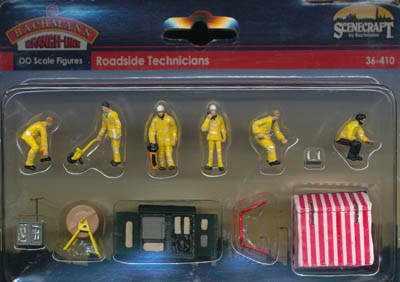
Average Height: 23 mm
We can do better than 'Roadside Technicians' - these are telecoms engineers, and anyone in the UK will be familiar with the sight of them on our streets. An interesting choice by Bachmann, but we like the scattergun approach that throws up sets like this, and this one is really rather good. With more content than most of the rest of the range, you get six figures plus some fairly meaty accessories. The figures are, from left to right, spray-painting in order to mark out some new digging, using a surveyor’s wheel to measure distance, carrying something (perhaps a multimeter), using a radio/mobile phone/test handset, (perhaps) feeding out cable and finally sitting on a small stool working on the first item in the second row with toolbox close at hand. That item is a large green cabinet much seen in British streets, and is a 'primary connection point', or wiring cab for short. Next to that is a safety barrier, followed by a maintenance engineering tent and lastly a cable reel. All these items are really nice, and perfectly correct for the modern day. Military or historic uses are very hard to imagine - all the men wear modern hi-vis clothing and are perfect as what they are, but probably for little else. The accessories are great, so a lovely product, but mainly for the intended market, which is model railways.
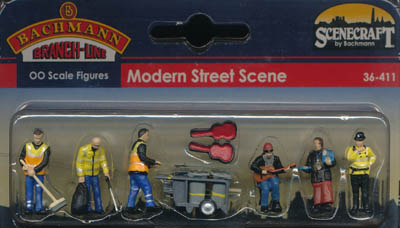
Average Height: 23 mm
This is another eclectic collection of modern figures, and all are often to be seen on the streets of the UK. Our top row is devoted to the street cleaners, all wearing the usual high-visibility jackets that we are all so used to seeing these days. All are nicely done and in very typical poses, and the cleaning cart is a really nice touch. A nicely complex little model, it is supplied already assembled and glued, so the bins cannot be removed. The third figure is presumably supposed to be pushing this cart, although his hands only meet the cart's handles if it is tilted forward on its rest, so he is not actually moving it at the moment, which is a pity.
The second row begins with a street entertainer (you might prefer the term 'busker'), sitting on a little stool and playing his guitar. Another nice figure, and clearly made up of multiple parts, but all glued and assembled at the factory, which includes the non-separate stool. The open case for collecting contributions is another nice feature. Next we have what looks to be a street seller, which in the UK means the Big Issue magazine, but doubtless there are equivalents in other parts of the World. This is a shortish lady in a hooded jacket, and she has her vendor licence around her neck as she should. Finally we have a police officer, appropriately dressed in high visibility tactical vest and bowler-type hat, which means she is far more typical of the appearance of police today than the previous very old-fashioned Bachmann set. She seems to carry an array of kit on her duty belt, as she should, though this is poorly detailed. In fact all the figures are fairly basic in detail, though this is only really noticeable on the police officer. The standard of painting is also fairly basic, though the figures are appealing at a distance, which on a railway layout is how they would normally be seen. Not much scope for use in more historic contexts, but these are nice figures and well thought out.

Average Height: 23 mm
Farming has obviously come a long way in the past few decades, with ever more mechanisation and larger, more efficient farms. Since crops are generally cultivated by large machines, we felt this collection of figures seems more appropriate to livestock, and those in the second row in particular seem to us relevant to the rearing of sheep. The dog is an obvious link to sheep of course, although it could just as easily be any kind of working dog or pet. The man with the stick seems to say shepherd to us, and we are guessing that the third man is perhaps shearing an animal, while the fourth might be taking away the resulting wool. The top row are more generic, and could work in less agricultural settings (the first man is carrying a couple of bits of wood on his shoulder).
Military modellers are often asking for more civilian figures, and if you are showing an army in the field then agricultural/peasant figures are top of the list. However this set is very much 'modern', which means they have a very narrow range of potential uses (sightseers for a modern military exercise perhaps?).
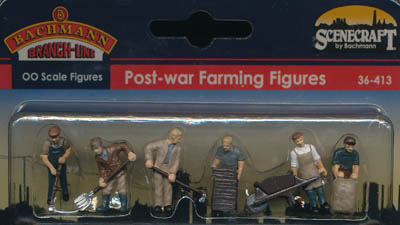
Average Height: 22.5 mm
Although this set is labelled as 'post-war', the clothing is pretty generic and would be suitable for a fairly wide period of time during the 20th century. In contrast to the livestock-oriented set above, this one seems aimed at arable farming. Of course these days that is highly mechanised, but here we have a group of men doing it the old-fashioned way, as you would expect in late 1940s Britain. First is a man with a scythe, and an appalling model it is too. The haft is straight, the blade is at the wrong angle and the handles are in all the wrong places. Just imagine how this man would move the tool, and you can see all he can do is drag the blade towards his knees. Useless, but a common fault in models of scythes. Beside him is a man with a fork - again facing the camera so hardly a natural position. Last in the top row is a man with a hoe. Not a great pose either, but the pick of the three.
The second row begins with a man pushing a wheelbarrow. The barrow is separate but happily it fits neatly into the ring hands and is at the correct angle, so makes a good general workman figure with lots of uses. Next is a man handling a sack of something, and lastly someone dealing with a pile of crates, perhaps containing soft fruit or something. Handling sacks (or sandbags) is pretty generic for military uses - armies have to eat after all - but the last man is harder to use outside of a railway. Nice figures all however.
Agricultural workers in the fields around the time of World War II could be of interest to some modellers, perhaps being interrupted in their work by the advance of tanks or invading troops. There is also some scope for figures in a support or logistics role perhaps, and all the clothing is generic working gear for the mid-century time frame, so looking past the basic paint job these simple figures could have some potential.
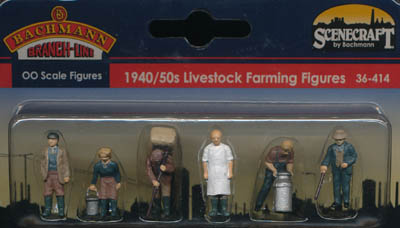
Average Height: 22.5 mm
Back to livestock farming with this set, and again with a World War II kind of period. We have people moving hay, milk and whatever is in that bucket, and a couple of men presumably managing a group of animals, plus a more ominous individual with a white apron on. Our first thought was of an abattoir, although perhaps he is involved in the milking process instead. Our second thought for this figure was a surgeon, although the boots don't give him a World War II military look. The other poses have little obvious use in a military setting, but perhaps that is just a challenge for some military enthusiast out there. The very basic paint job does not flatter what are adequate but pretty dull sculpts, but for a livestock farm of the period these are decent figures which might also be seen in some village landscape too.
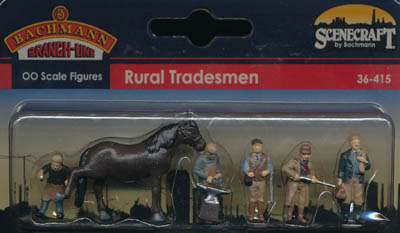
Average Height: 21.5 mm
With this set we have two themes that are almost timeless - the blacksmith and the country estate. One smith is working on the raised hoof of the horse while the other is holding an item in a pair of tongs as if about to rest it on the anvil. Their clothes of course are not so timeless (the first looks to have jeans and a T-shirt), yet are vague enough to be more or less appropriate for a good long period of time, especially if given a suitable repaint. The poses would be common in any army up to well into the 20th century, and in most villages too.
The second row begins with two figures that are presumably gamekeepers, a job that also stretches back through the centuries, although either could also be the land owner out for a hunt. The clothing would work for the last 150 years or more, and the shotguns are without any detail, so don't restrict their use too much. The second of this pair has a large satchel on his back with several silver-painted things sticking out of it, but we couldn't interpret these. Finally we have a man in boots, trousers and jacket, with a coat flung carelessly over his shoulder. As such he could be anyone, but in his right hand he holds a Gladstone bag, which immediately makes you think of a doctor or a vet. Gladstone bags such as this date from the middle of the 19th century, so he is a useful civilian figure for any period after this. As elements on a railway layout they would be background decoration and not intended to be the focus of anyone's attention, and the same might well be true on any military diorama, so the basic sculpting and painting might not be too much of a problem for these rural figures.
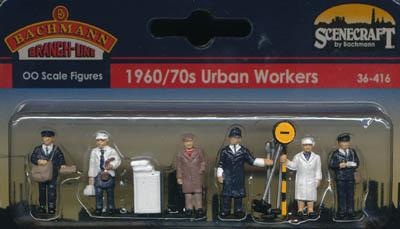
Average Height: 22 mm
For anyone growing up in a British town during the 1960s and 70s, this set will have quite a strong nostalgic appeal as most of what we can see here is not to be found today. As always, Bachmann have provided no identification of these figures, but those of a certain age will have little difficulty in recognising some workers commonly seen on the streets. The first is a postman, wearing the peaked cap and smart uniform of a bygone era (including shirt and tie), and carrying a large satchel that would not be much different today. In his left hand he holds a packet, and like the rest of these figures he seems to be standing still. Next is another worker once seen early in the morning: a milkman. Long since extinct, these used to deliver milk to households early every morning, and also some other items such as bread, which is perhaps what he cradles in his left arm. Again with a peaked cap, shirt and tie, he also wears an apron under his jacket, and has his takings purse around his waist. In his right hand of course he carries eight glass bottles of milk.
The third figure is just a man in an overcoat and wearing a flat cap, but the stand next to him shows he is a newspaper seller, and a very typical look this is too. The face is crude, but it would have been nice to have this man crying out, encouraging the passers by to buy the newspapers on his stand, which those who are so inclined might even like to paint with some headline, as was the norm at the time. The fourth figure is someone you still see on the streets of Britain. They go by various names around the World, but in Britain they are popularly known as a lollipop lady (or man). They supervise the crossing of roads by pedestrians, particularly children, and in some ways their appearance has changed little since the 1970s. The 'lollipop' this lady holds is much the same, and they still wear a long coat since they must work in all weathers, but whereas in this period they were white, now they are invariably high-visibility yellow with reflective strips - a simple repaint will effect the conversion.
The fifth man echoes a similar figure in the Airfix civilians set, and is clearly a policeman directing traffic. He wears the long overcoat of the period, together with the reflective white cuffs used when performing traffic control. While the sculpting is basic, his helmet (which is poorly shaped) seems to have a raised crest. Lastly we have a figure that briefly puzzled us, as he wears much the same uniform and cap as the postman. However the presence of the parking meter tells us he is a traffic warden. He holds a pad as if issuing a ticket, and is correctly dressed, although he should have been given a bright yellow band round the cap, which used to be their most distinguishing feature. The parking meter is a nice touch, partly to help us identify the warden, and note that the set contains four of these items, even though we have only photographed one.
To be honest, it would be a real stretch to suggest any great use for these figures as anything other than what they are. Military uses might be virtually zero, but a fun collection nevertheless.
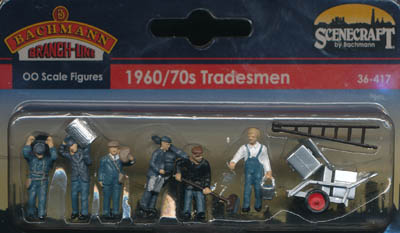
Average Height: 21.5 mm
The nostalgia continues with this small collection of tradesmen, some of whom have largely disappeared. The first figure is a coalman, delivering a heavy sack of coal carried on his back. Before the widespread use of central heating this was a common sight on Britain's residential streets. Also common is the next figure, a dustbin man or refuse collector. Naturally these are still going strong, but these days they wear high visibility suits and don't carry large metal dustbins like this. Third is a chimney sweep - another tradesman with little custom these days, but the fourth figure is a mystery. He wears a suit and tie, a flat cap on his head, a sort of purse on a strap, and is carrying a sack or large bag of something on his shoulder. What he is we cannot guess.
The second row has a more up to date look about it. First we have a street cleaner along with his barrow. Again, such cleaners would probably wear high visibility suits these days, and the barrow design will have changed, but the basic function is unchanged. The barrow is particularly nicely done - the basic frame is one piece, and each of the two bins is separate, so you could switch them round if you like. Finally we have a window cleaner. Whether they wear dungarees like this these days we do not know, but he is pretty generic, and reminds us of the sole human figure in the Airfix Zoo Set 1. His ladder is a separate piece, and fits well onto his arm (better than our photo suggests). Another charming set, but again little obvious use for military situations.
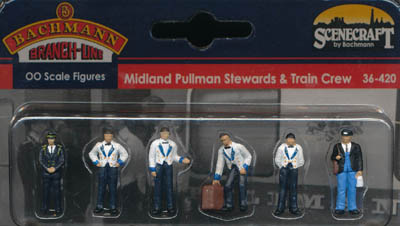
Average Height: 22 mm
The Midland Pullman was a luxury, all-first-class British train that ran between London and Manchester from 1960 to 1966. Part of the word luxury in this case means of course plenty of staff to attend to the passengers' needs, so most of the figures in this set are concerned with passenger service. The stewards wear the white shell jacket, and these immediately put us in mind of mess dress as found in the British, US and Commonwealth armies from the Victorian era onwards. Naturally they would need to be repainted, and the match is not perfect, but since no one is really likely to make military figures in mess dress, this is as close as we are ever likely to get. The fifth pictured figure is presumably the senior conductor, and the last must be the driver. Both wear a cap with no front peak, which we think must be wrong, and reflects the fairly basic standard of sculpting here (notice no one has a face worthy of the name). Like the rest, these are not intended for close scrutiny of course, but to decorate a train or layout and be seen at a distance (and at speed). For the same reason the factory painting is rough when examined closely, but at least customers can replace that if they wish. So basic but not without potential.
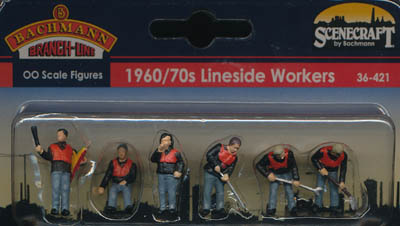
Average Height: 22.5 mm
Railways require a lot of maintenance of course, and this set shows this work as it would have looked in the 1960s and 70s. All the men wear the same jacket and trousers, and for safety reasons they all wear a hi-vis vest. Once again, today this would be a full suit, but even so, accidents and deaths still occur in this dangerous task. The figures are engaged in various activities, which thanks to a multiple-part approach (assembled and painted at the factory) gives a realistic pose. The penultimate figure is perhaps clutching a number of coloured flags, though we do not know what he holds in his right hand. The last figure is perhaps either shouting or blowing a whistle to warn of the approach of a train (or that the tea is ready). Another nicely made set despite the crude paintwork, but with little apparent value for the military modeller.

Average Height: 22.5 mm
Any layout set in modern times will have roads and road vehicles, and a garage is a popular element to add, particularly as many rail enthusiasts are also interested in cars. This set offers us six generic mechanic figures in reasonable poses that would decorate such a garage. The first three are empty-handed, but we particularly liked the man lying on his back and working underneath some vehicle, although most layouts will probably only ever show his legs! The fourth man is walking and carrying a tool box and a spanner, while the fifth looks to be drinking a cup of tea. The sixth, who is the only one not wearing overalls, is presumably in charge and is holding a clipboard perhaps? All perfectly reasonable, generic poses, and ones that the military modeller might also find useful. Men wearing overalls and working on vehicles would make perfect sense in a military motor pool, tank workshop, naval or aviation setting, so with suitable painting these would have many 'away from the battle' possibilities.
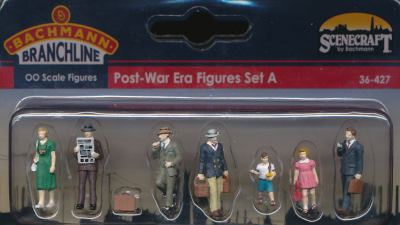
Average Height: 23 mm
Post-War is a popular era for model railway layouts as it represents the final hurrah of the steam engine, but also includes diesel and electric rolling stock, and for modellers of a few years ago this represented the period they remembered fondly as children. This first collection of passengers from the era is a really nice group, marked out as typical of the 1940s and 50s by the fact that the men all wear suits or blazers, and most wear a hat. The woman with the camera around her neck is a nice piece too, and the little girl carrying her bucket and spade has loads of charm. The printing on the newspaper is a great feature, although we were not so taken by the enormous cigar being carried by the last man, but our favourite pose is the man smoking and leaning up against a wall. In fact all are really good, and make perfect platform figures, so while not particularly useful for military modellers, they are appealing figures in their own right.
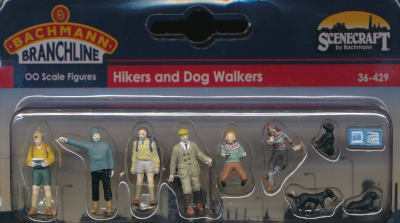
Average Height: 23 mm
Any layout of a decent size will be likely to show trains passing through the countryside, so having a few character figures to add interest to that landscape seems like a good idea, and was presumably the rationale for this set. The figures largely speak for themselves, although we are not sure what the blue item in the top row is; our guess is perhaps some sort of picnic basket for the sitting/kneeling people? The two figures in the bottom row are quite a nice contrast, the first being wrapped up in modern clothes against the elements while the second has a much more traditional look to him. The dogs, which are also nicely done, have been painted in all black, which doubtless was a relief to the factory painters, although they have rather gone to town with the elaborate and fiddley patterns painted on the two picnickers.

Average Height (men only): 23 mm
There is no date associated with this set, but an inspection of the uniforms confirms it is intended for World War II, or at least the early to later 1940s. The three services are evenly represented, beginning with two figures for the Army. The first wears battledress of the period (although he has two front large pockets on the legs when only one ever existed) and a sidecap. He carries two suitcases and has a bag of golf clubs slung on his back, so clearly is looking forward to some relaxing rounds. The officer to his left wears normal No. 2 dress, with jacket and peaked service cap. He has raised his right hand, which has a mysterious sliver blob painted on the back – is he supposed to be looking at his watch perhaps? Next we have a naval rating wearing the usual ‘square rig’ and carrying a duffle bag on his shoulder, followed by a standing WRNS officer in reefer jacket and cap. The reefer jacket should be double-breasted but is sculpted as single, even though it has been painted with two rows of buttons, and the officer’s tricorn cap is also a very poor representation of the real thing. The last two figures are for the Royal Air Force, beginning with a WAAF wearing a standard if slightly short greatcoat, and a normal WAAF hat. The male airman next to her is perhaps also wearing a greatcoat, although it is single-breasted and looks more like a civilian raincoat to us. His sidecap is also a poor model. He too carries a case, but lacks such extra luggage as his helmet or gasmask case, as do most of these figures, which suggests this is not actually wartime, so best for the months after the war in Europe came to an end.
While there are many sets of British forces for World War II, most are in battle, so there are still few figures for background scenes such as at camp, let alone ones suitable for when on leave. Despite the poor factory painting and the mistakes in uniforms, these still offer some basic services figures for a time when any railway station would see large numbers of such uniformed men and women. The RAF figures in particular could also be useful for scenes of wartime airfields, so there is plenty of scope for using these figures beyond railways.

Average Height (men only): 23 mm
While the range of rolling stock to cover all periods of railway history has expanded greatly in recent years, accessories, especially figures, have not matched that growth, so it is particularly pleasant to see this set, the first pre-war passenger set from Bachmann. The figures are of four well-dressed gentlemen and two ladies, all in outdoor wear as they would be if they were taking a train. Three of the men wear coats, while the fourth is seen just in his suit. All wear a hat of course, and we find a top hat, a couple of bowlers and a deerstalker. All carry a cane, all of which gives the impression of well-off passengers, particularly the man in the top hat. The first lady wears the very fashionable big hat of the period (first decade of the 20th century), along with a long dress that is tight around the waist and reaches to the ground. The parasol that she holds is a nice touch. The second lady has a suit on and has the much more modest toque hat which appears later in the decade, and since she carries her own bag and small piece of luggage, she seems less wealthy than the first. The basic factory painting does not flatter these figures, all of which are standing still, but the sculpting is quite variable, with the top-hat gentleman being especially poorly done as he has no face to speak of at all. That the painter has attempted to show a mouth with a thick black line just makes matters worse, so if these figures are to be seen close up rather than as just a tiny piece of a much wider vista, then a lot of improvement work will be necessary. Nevertheless, it is great to see civilians for this time period, and their use could certainly extend as far as the Great War and beyond.

Average Height: 23 mm
Signalling is something that the travelling public sees little of, and in the modern era, signals under central control and ETCS systems in cabs mean signal boxes are fast disappearing and there is almost no visible evidence of signalling at all. In the age of steam of course such sophistication was undreamed of, and signalling was much more of a hands on process. The first two poses in this set are similar, and show a man pulling or pushing a lever in a signal box to change a signal and/or points. The different colour would have helped the signaller to identify which signal did what. The third and fourth poses are generic ones that would work perfectly well in staffing a signal box somewhere, but the fifth man is all about train safety rather than signalling. He holds up a token, which is an object with a large loop, the possession of which entitled the train to enter a particular section of track. This is the one-train-working system, and is not something you would see on a modern train network, but on single track lines in the earlier days of train travel, ensuring a train could only proceed if they physically had the token on board helped to avoid collisions. This man is holding the token up to be grabbed by the crew of the slow-moving passing locomotive, and he also holds out his left arm in order to collect the token the train already has for the section it has just vacated. The last figure would be outside, and as he holds a lamp and a flag, he is presumably controlling trains from the trackside. All are smartly dressed, as you would expect of the era, even though they would be little seen by the public, and make perfect staff for an old signal box. However, their role is clearly very specialised, and it is hard to see any other uses for these figures.
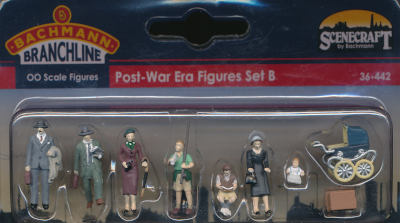
Average Height: 23.5 mm
More figures for the popular post-war period, and again we have random people perhaps waiting on platform or just in the street. All are much more smart than a typical group of passengers today, since at this period it was still fashionable to dress smartly when travelling, although of course any could be going to the office, for example. Nonetheless the men's smart suits and hats, and the women's fashion, all match the 1940s and 50 perfectly, and the children look good too. One boy is sitting and reading (perhaps a comic) while the other holds a fishing rod and is about to take a drink from a bottle. The pram is a further nice touch that is fine for the period, and having a separate baby on board (or even flying above it as we have photographed it!) is a further cute touch. The only purpose we can see for the box is as a seat for the boy, but it is good to see so many people carrying luggage, as you might expect at a railway station, so this is another really nice period set.
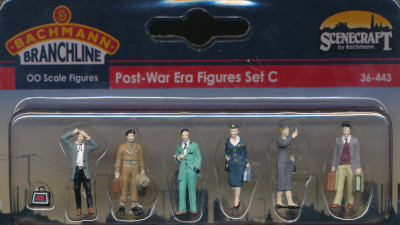
Average Height: 23.5 mm
Another set for Britain's railways during the years after the war, and this time Bachmann have made a set very firmly planted in those years. The first two figures are clearly 'Teddy Boys', a phenomenon that appeared in the early 1950s and included a love of the new rock and roll music and the wearing of colourful outfits somewhat reminiscent of American zoot suits. Many saw this as a rebellious trend, which it was to a degree, and so disapproved, which pleased many of the youngsters enormously. We loved the look of these two, and particularly the care in painting their footwear as typical crepe-soled shoes, plus the fact that one is taking great care over the look of his hair. The second pair of poses would seem to be airline hostesses. They both wear typical uniforms of the day, and one carries a flight bag with a logo looking very like that of an airline such as Lufthansa. Both are just walking, although one seems to be more interested in looking at herself in her compact. In stark contrast to the Teddy boys we then have a young man probably on his way to or from his National Service. In the UK National Service (conscription) ran from 1939 to 1960, with the last man completing his service in 1963, so it would have been a common sight to see such a man waiting at a station, carrying a small case and his large kit bag. A random final traveller with two cases, and an equally random extra bag, complete this fun little collection that manages to provide some classic 50s icons that would attract attention in any railway or diorama of the period.
|